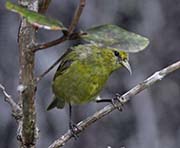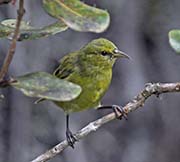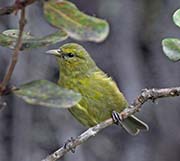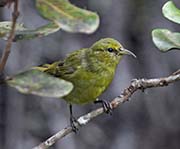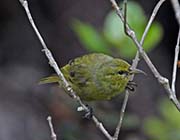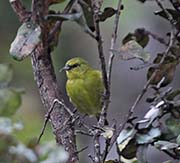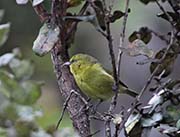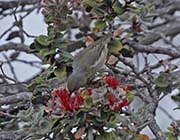Amakihi - Hemignathus virens
| Length | |
| Weight | |
| Clutch Size | |
| Chicks at birth | |
| IUCN Conservation Status | |
Continents: |
Hawaii `Amakihi is part of the Hawaiian honeycreeper subfamily and is found on the Big Island of Hawaii, Maui, and Molokaii. The island of Kauai and Oahu have a similar bird, but they are considered a distinct species. The `Amakihi on the Big Island and Maui are the same species but, they have visual differences.
Hawaiian `Amakihi have survived the changing environment better than most native Hawaiian birds which may be partly due to their resistance to avian malaria which has decimated some of the other native birds.
The Hawaiian `Amakihi is a small yellowish-green bird with a relatively short decurved bill. They have brown eyes with black pupils and black lores. The female tends to be darker.
Diet: Hawaiian `Amakihi eat a variety of foods which has helped its survival. They drink nectar from flowers (mostly 'ohi'a, mamane, and lobelias), suck juice from fruits, eat tree sap and eat spiders and insects from trees and shrubs.
Courtship: Hawaii `Amakihi are monogamous and the pair bond may extend across mating seasons. Courtship consists of courtship chases, "flitting" display, singing, courtship-feeding, etc.
Nesting: Hawaiian `Amakihi can raise 2 broods per season (Nov.-July). There seemed to be disagreement on the nesting for the Hawaii `Amakihi. It is unclear if both sexes or just the female constructs the nest which is made of woven plant fibers.. Also, one source said only one egg is laid, another 2-3 eggs.
Since they are passerines, the chicks are helpless at birth (mostly featherless) and usually fledge in two to three weeks. Chicks are fed by both parents (mostly the female) by regurgitating insects and nectar.
Habitat and Range: Hawaiian `Amakihi are found in native forests and dry shrublands from sea level to the subalpine zone.
Vocalization: Hawaiian `Amakihi have two songs. The first is a trill and is sung by the male and is considered a territorial song. The second song is sung by both sexes but the male sings a more complex version than the female and may be a mating song.
Plumage/Molt: Adults molt annually at the end of the breeding season.
Migration: Hawaiian `Amakihi are considered non-migratory but some altitudinal movement happens probably due to food availability.
Tongue/feet: Hawaiian `Amakihi have tubular tongues with fringed tips.
Bibliography:
- http://en.wikipedia.org The Free Encyclopedia, Accessed June, 2012
- http://bna.birds.cornell.edu/bna The Birds of North America Online from the Cornell Lab of Ornithology, Accessed June, 2012
